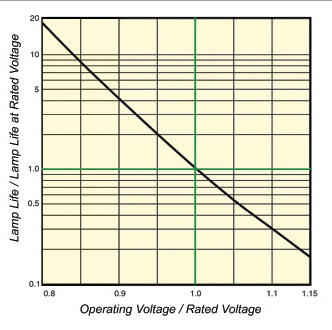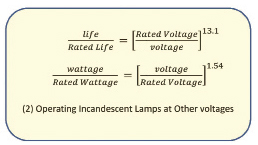Calculations to Justify a Lighting Retrofit

Bill Klages
Every broadcaster has moments when their thoughts turn to the merits of changing to solid-state lighting in their facility. One of the primary attractions is the idea that the efficiency of the new LED instruments will result in significant savings in electrical energy.
Estimating the pay-back period of the investment is a quick and practical method to initially evaluate the financial benefit of a retrofit. The procedure is very straightforward and easy to accomplish.
First, the current operating cost of the existing lighting system is calculated for a year. In a similar manner, the yearly operating cost for the new lighting system is also estimated. Assuming that the retrofit results in savings, the difference in operating costs between the two is then computed.
The (simple) pay-back period is the time period needed to accumulate the return of the total installation cost of the retrofit system and forms the basis for determining the desirability of a retrofit. This time period is the total investment cost divided by the yearly savings.
CURRENT OPERATING COST
This article will only address the computation of the current cost of operating a traditional lighting system using incandescent fixtures. The complete calculation for obtaining pay-back period will be left for a future article.
The elements that are contained in the operating cost are: (1) the electrical costs to operate the lighting equipment; (2) lamp replacement costs; (3) air-conditioning costs for removal of the heat generated by the lighting instruments; and finally, (4) the labor cost of lamp replacement.
The professional video industry's #1 source for news, trends and product and tech information. Sign up below.
In my experience, the cost of lamp replacement need not be included as it is insignificant and is easily handled by studio operating personnel in the course of their normal tour.
Fig. 1: The relationship between actual/rated voltage and lamp life.A DIFFERENT APPROACH
To make the lamp operating costs more realistic, I am going to suggest a different approach in predicting lamp power and life expectancy. In normal use, lamps are not actually operated at the rated voltage of 120 volts. Not only is there a slight voltage drop through the distribution system, but the dimmers are generally not operated full. This fact results in a large change in expected lamp life as well as the actual electrical power used.

Fig. 1 illustrates the relationship between actual/rated voltage and lamp life. You will note that the lower the operating voltage, the longer the lamp life.
Fig. 2 shows the accepted formulas that are valid for estimating life expectancy and wattage required as the operating voltage deviates from the rated voltage.
It is my opinion that these should be utilized in determination of lamp life and wattage for use in obtaining the yearly operating costs of the “old” lighting system.
ILLUSTRATIVE EXAMPLE
As an example of the results of this method, let us say that on our lighting console, a channel slider is positioned at about 75. Assuming a typical “square law” console, a scale reading of 75 would probably operate the lamps at about 100 volts and would deliver about 60 percent of the light obtained at “full.” (The color temperature would be about 3,000 degrees Kelvin rather than 3,200 degrees Kelvin, not really a problem). Substituting this voltage value in the formula shows that the life would be extended more than 10 times.
Applying this operating voltage in the wattage formula results in a power usage of about 75 percent of what would be required at rated voltage. To be on the conservative side, 108 volts would seem to be a good arbitrary value to use in the calculation rather than doing the tedious procedure of documenting each fixture’s level. This would correspond to a slider position of about 85, a good compromise average. As a result, the lamp life would be extended about four times, and the power required would be about 85 percent of the rated lamp power.
As an example, an EGT lamp used in a 1,000 watt Fresnel spotlight is rated at 250 hours. Let’s say that our studio is heavily utilized, about 3,000 hours per year. Using the rated lamp life we would theoretically have 12 lamp replacements per year. Using the more pragmatic approach would give the more realistic replacement quantity of three. As far as the lamp replacement cost to be used, I would suggest actual “street” price rather than lamp list price.
Fig. 2: Accepted formulas for estimating life expectancy and wattageA/C AND HEAT REMOVAL
There can be significant savings in air-conditioning requirements as it is directly related to the efficiency of a lighting source.

In the case of an incandescent lamp the amount of heat that must be removed is generally accepted as equal to 90 percent of the input power. In our case, this would actually be the product of 85 percent of 90 percent or (1000)(0.90)(0.85), or 765 watts in the case of the EGT lamp.
The final calculation of energy required to remove the heat generated from the lighting system should also take into account the weather zone of the facility to account for anticipated number of cooling days.
OPERATING-COST CALCULATION
The final step should be obvious at this point. Spreadsheet calculation would seem to be the most direct manner to create the list of all our studio equipment, estimate studio usage, apply necessary factors, and then calculate our yearly operating cost. As mentioned, this will be covered at a later article.
It is anticipated that the biggest issue in the retrofit process will be finding substitute fixtures. Performance is the key consideration. It is my opinion that a complete selection of solid-state fixtures does not exist that duplicates the entire selection of traditional instruments based upon filament sources.
Although large-aperture, soft-light replacements are numerous, a full range of spotlights is not available. If your complement needs the performance characteristics of a spotlight greater than 650 watts, there is no equivalent LED fixture presently offered. It is hoped that time will change this dilemma.
Bill Klages would like to extend an invite to all lighting people to give him your thoughts atbillklages@roadrunner.com.
